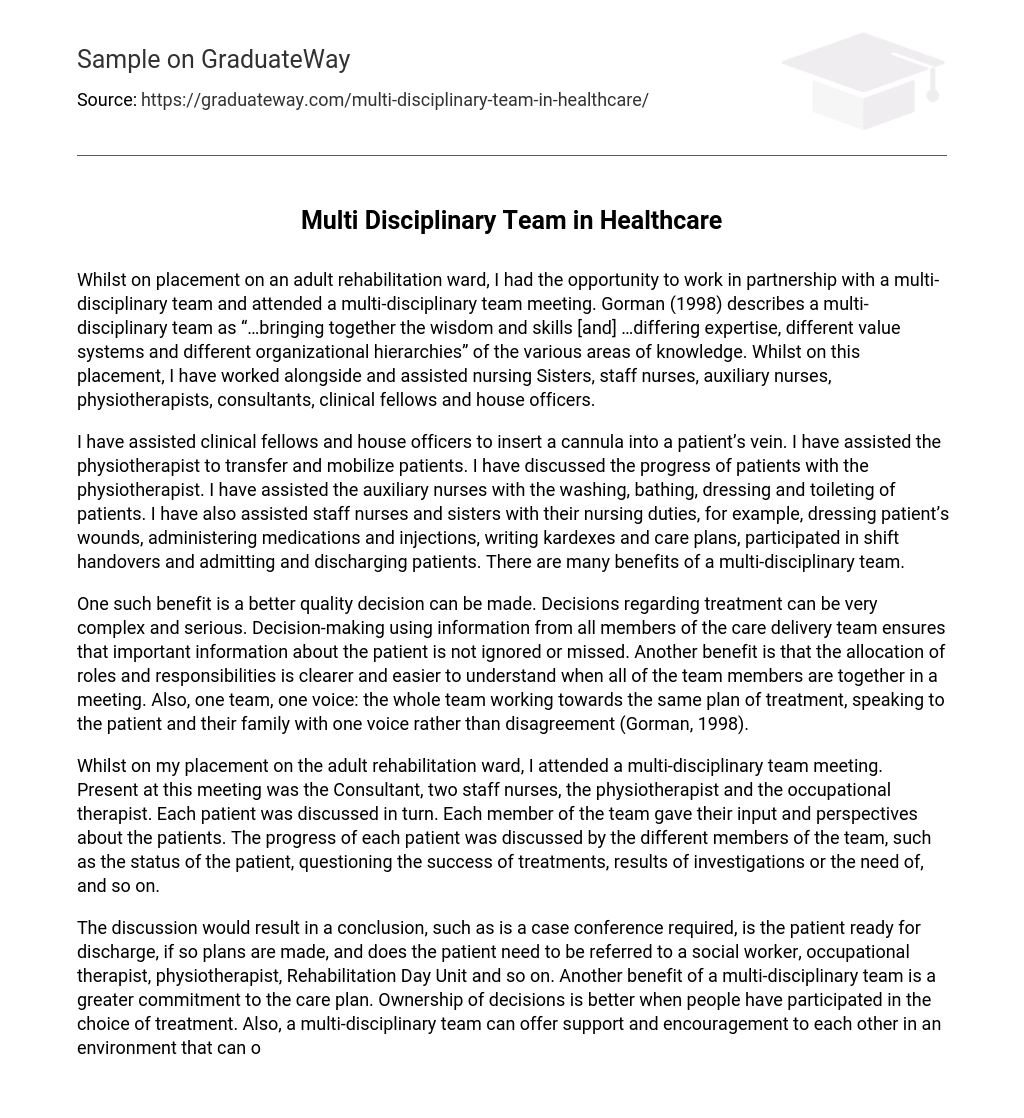While on an adult rehabilitation ward, I had the opportunity to work with a diverse group of professionals. This team included nursing Sisters, staff nurses, auxiliary nurses, physiotherapists, consultants, clinical fellows, and house officers. We formed a multi-disciplinary team as described by Gorman (1998), where individuals from different fields come together to share their expertise and perspectives. Furthermore, I attended a multi-disciplinary team meeting during my placement.
In my role, I have provided assistance to clinical fellows and house officers in inserting a cannula into a patient’s vein. Additionally, I have aided the physiotherapist in transferring and mobilizing patients. I have engaged in discussions with the physiotherapist regarding patient progress. Furthermore, I have supported auxiliary nurses in tasks such as washing, bathing, dressing, and toileting patients. Moreover, I have assisted staff nurses and sisters with various nursing duties, including dressing wounds, administering medications and injections, writing kardexes and care plans, participating in shift handovers, and admitting and discharging patients. The presence of a multi-disciplinary team offers numerous benefits.
One advantage of team decision-making is the ability to make higher quality decisions. Decisions related to treatment can be intricate and significant. By incorporating input from all members of the care delivery team, important patient information is less likely to be overlooked or disregarded. Additionally, having all team members present in a meeting clarifies and simplifies the allocation of roles and responsibilities. This unified approach allows the entire team to work towards a common treatment plan and speak with a consistent voice to the patient and their family, minimizing any potential disagreements (Gorman, 1998).
While on the adult rehabilitation ward, I joined a multi-disciplinary team meeting that involved the Consultant, two staff nurses, the physiotherapist, and the occupational therapist. Our discussion revolved around each patient individually, with everyone providing their thoughts and opinions. We talked about each patient’s progress, including their present condition, how effective their treatments were, the outcomes of investigations conducted, and any additional requirements they might have.
The conclusion of the discussion may include a case conference, assessing the patient’s readiness for discharge, making plans, and referring to professionals such as a social worker, occupational therapist, physiotherapist, Rehabilitation Day Unit, and others. Moreover, having a multi-disciplinary team leads to increased commitment to the care plan. When individuals participate in decision-making about treatment options, they are more inclined to take responsibility for those decisions. Additionally, a multi-disciplinary team can provide support and encouragement to one another in an often stressful and demanding environment (Gorman, 1998).
While I was in the rehabilitation ward, I observed two patients pass away. These were tough experiences for me, but the clinical fellows and nurses provided me with invaluable support and guidance during these difficult times. Effective communication is crucial in a successful multi-disciplinary team. This involves sharing knowledge and skills, actively listening, and respecting diverse perspectives (Gorman, 1998).
Having effective communication in a multi-disciplinary team is essential because it allows for collaboration and enhances patient care. For example, if nurses have an occupational therapy appointment scheduled at 9:30 a.m. to evaluate the patient’s dressing skills, it would be unwise for them to hastily dress the patient before that time. Likewise, if a physiotherapist encourages the patient to move with minimal assistance, it would hinder progress if nurses consistently rely on a wheelchair to transport the patient.
Effective communication is crucial for the continuity of care (Squires, 1988). Collaborative efforts among multi-disciplinary teams lead to improved patient treatment and better quality of work life for the care delivery team members (Gorman, 1998). Initially, I felt anxious during shift handover, but with time, it became less daunting. However, I often fretted about whether I was providing enough pertinent information to the next shift. It is important for me to acquire the ability to differentiate between relevant and irrelevant information for effective handover and care plans.
References.
Gorman, P. (1998) Managing Multi-Disciplinary Teams in the NHS. London: Kogan Page Limited.
Squires, A.J. (1988) Rehabilitation of the Older Patient. A Handbook for the Multi-Disciplinary Team. London: Croom Helm Limited.





